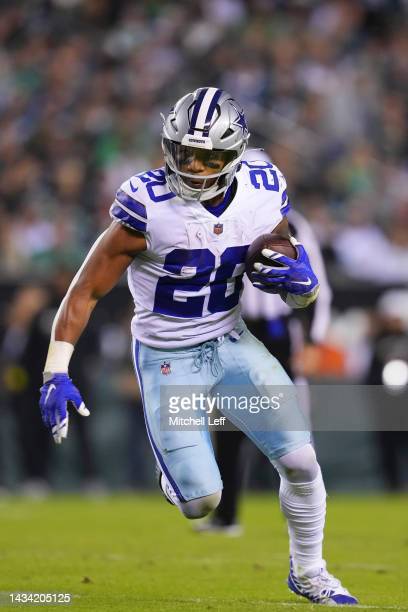Breaking Down the Fantasy Relevance of the NFC East
The NFC East was a juggernaut in offense last year. Three of the four teams made it to the postseason. One of the teams made it to the Super Bowl.
Regarding fantasy relevance in PPR leagues, the NFC East gave fantasy managers two top-10 quarterbacks, running backs, and wide receivers. There was one top-10 tight end, but he moved to another division.
The NFC East has plenty of other movements. All teams will have new offensive coordinators. The Washington Commanders will have a new quarterback under center. The Dallas Cowboys will be without Ezekiel Elliott (for now), and the New York Giants will possibly be without the services of Saquon Barkley. Barkley signed a 1-year deal worth up to $11m.
So, who will be fantasy relevant for fantasy managers in the NFC East?
Dallas Cowboys and Offensive Coordinator, Brian Schottenheimer
Kellen Moore is no longer the offensive coordinator in Dallas. With Moore, the Cowboys had a top-six scoring offense three out of the last four years. In 2021, the Cowboys were the first scoring offense with 30.4 points per game. Last season the Cowboys were fourth in scoring with 26.8 points per game.
Although Schottenheimer is now the offensive coordinator, head coach Mike McCarthy will call plays. McCarthy has stated, “I don’t desire to be the No.1 offense in the league. I want to be the No.1 team.”
2023 Offensive Acquisitions and Losses
As mentioned earlier, the Cowboys’ released Elliott. They also lost the services of wide receiver Noah Brown and tight end Dalton Schultz. Schultz finished last season as TE10. Last season Schultz was seventh in targets (89), 10th in target share (18.7%), and ninth in target rate (23.9%).
Michael Gallup is slated to return from his injury-shortened season, where he played 14 games. The team acquired wide receiver Brandin Cooks from the Houston Texans. Cooks season was also shortened by injuries and stalled by poor quarterback play last season. Cooks played in 13 games and averaged 11.2 fantasy points per game.
The Cowboys are also counting on the return of running back Tony Pollard, who was injured in the playoffs last season. The Cowboys acquired running back Ronald Jones II. Jones participated in six games last season.
The Cowboys used three picks on the offensive side of the ball in the 2023 NFL Draft. They drafted:
Round 2, Pick 58: Tight End, Luck Schoonmaker
Round 6, Pick 212: Running Back, Deuce Vaughn
Love our content? Check out the GoingFor2 Live Podcast Network!
https://twitter.com/ParisaMichelle/status/1682186610442485760?s=20
Round 7, Pick 244: Wide Receiver, Jalen Brooks
Fantasy Relevance of the Dallas Cowboys
Quarterback, Dak Prescott
Last season Prescott injured his thumb in Week 1 against the Tampa Bay Buccaneers. The injury required surgery and Prescott did not return until Week 7 against the Detroit Lions.
Still, Prescott finished with the third most passing touchdowns in his career (23). He also had career-high interceptions (15) and finished with the second-lowest fantasy finish of his career (QB18).
McCarthy’s theory appears to be to run the ball to rest his defense. However, the Cowboys’ had the seventh-highest run rate in neutral situations last season. They were ninth in rushing yards (131.7) and seventh in rushing attempts per game (30.9). A radical change is not expected.
Per fantasyfootballcalculator.com, Prescott’s current ADP is the ninth pick in the seventh round. Last season’s QB18 finish was with Prescott missing Weeks 2-6. His 213.6 overall fantasy points averaged 17.8 for the season. By average, he would have finished as QB15.
Prescott hasn’t been a dual-threat quarterback since his brutal ankle injury in 2020. Before the injury, Prescott averaged 19.7 yards and 0.13 rushing scores per game. After returning from the injury, Prescott has averaged 11.7 yards and 0.07 rushing scores per game.
Last season Dallas was down 5.5 passing attempts per game from the previous year (38.4-32.9). The 32.9 was 19th in the league.
Lowering the expectations on Prescott because of his lower ceiling on rushing could backfire this season. Without Elliott on the field, Prescott could get more goal-line carries. Elliott was responsible for 16 carries inside the five-yard line (third most in the league). If Prescott can pick up half of those, there won’t be rushing yards per se, but rushing touchdowns are in play.
It’s a new offense with a new play caller and without stalwart Elliott. Pollard and Michael Gallup are coming off injuries, and Prescott’s security blanket, Schultz, is gone. The seventh round still feels like a steal.
Wide Receiver, Cee Dee Lamb
http://receptionperception.com/ceedee-lamb-20…pic.twitter.com/ZeGBhZ87Ux
Last year was Lamb’s first opportunity to be WR1 in the Cowboys’ offense. He finished with 156 targets (fourth in the league), a 28.7% target share (ninth in the league), and a 30.1% target rate (seventh in the league).
Remember Weeks 2-6, and Lamb played without Prescott. Without Prescott under center, Lamb averaged 76 yards per game. When Prescott returned, Weeks 7-18, Lamb averaged 86 yards per game and 8.9 targets. In those weeks, he finished as WR3 in fantasy PPR scoring.
Lamb finished with 107 receptions, 1359 receiving yards, and nine touchdowns for the season. Lamb was ninth in deep targets with 26 and ninth in yards after the catch with 474.
Even with the acquisition of Cooks, Lamb’s ceiling remains high. Although he was 18th in red zone targets (15), only 14% of his fantasy points came in the red zone. There is room for a position regression there, and with the losses of Schultz, Elliott, Brown, and T.Y. Hilton, there are potentially 196 targets up for grabs.
Lamb is currently going at the beginning of the second round. His current ADP puts him at WR6. There are fears of him losing some ground with a healthy Cook and McCarthy’s play calling. But there are plenty of available targets to be had, and the last time McCarthy called plays in Green Bay, the Packers’ number one receiver averaged eight targets a game with a 23% target share.
Lamb’s floor should be WR6.
Tight End, Luke Schoonmaker
The Cowboys selected Schoonmaker in round two. He will be competing for the starting role with Jake Ferguson and Peyton Hendershot. Last season Ferguson played in 16 games. He had 22 targets, a 4.3% target share, and a 25.6% target rate. Hendershot is an undrafted rookie.
The reason to be optimistic is that since Prescott has been under center in Dallas, the tight end position has had a 20% target share and averaged 113 targets per season. The reason to be pessimistic is not only the rookie tight-end productivity curve is low, but Schoonmaker will be competing with Lamb, Cooks, and Michael Gallup for targets in what appears to be an offense with a target ceiling.
Running Back, Tony Pollard

Pollard is efficient both on the ground and through the air. He was RB8 last season, and he did this with only 232 touches and playing on less than 50% of the snaps in eight games.
In the passing game, he was fourth among all running backs. He had 1.82 yards per route run. With a 10.9% target share, he averaged 9.5 yards per reception.
On the ground, he averaged 5.2 yards per carry, with 3.3 yards created per touch. And 8.8% of his runs went for at least 15 yards, the fourth-highest rate in the league.
Pollard did this while sharing time with Elliott. Last season Elliott was on the field for 48.02% of the snaps and Pollard for 48.97%. Elliott is currently no longer with the team.
When Pollard played 53% of the snaps (Weeks 7-16), he scored more fantasy points than another running back, 19.3. Now Pollard will have the first run (see what I did there) of Elliott’s 40 red zone touches and 12 total touchdowns.
When Pollard carried the ball 10 times or more, he averaged 19.3 PPR fantasy points. Per Next Gen stats, 16.1% of Pollard’s rush attempts went for 10 or more yards. That was the most of any running back. He also missed 41 tackles and averaged 3.82 yards after contact per attempt.
Pollard injured himself in the playoffs last season. By his indications, he will be ready to play when the season begins. At his current ADP, going at the end of round two, the desire for the head coach to “run the ball more,” and the current state of running backs still unsigned or perhaps sitting out the season, Pollard will be going in round one.
New York Giants and Offensive Coordinator Mike Kafka
Last season the Giants greatly exceeded expectations. They finished 9-7-1 and were the sixth seed in the NFC playoffs. This season DraftKings has the Giants’ win total over/under 8.5 games. The question isn’t only will the Giants once again exceed expectations, but also can this help our fantasy teams?
2023 Offensive Acquisitions and Losses
The Giants acquired wide receivers Parris Campbell, Jeff Smith, and Jamison Crowder in free agency. They also resigned wide receiver, Darius Slayton. They recently acquired Cole Beasley.
While they placed the franchise tag on running back Saquon Barkley, the Giants also acquired running back James Robinson. Barkley has not signed his franchise tag. The tight end Darren Waller was acquired via trade.
In the 2023 NFL Draft, the Giants had seven picks. Two of their draft picks were spent on weapons for the offense. The picks were:
Round 3, Pick 73 (from LAR via HOU): Jalin Hyatt, Wide Receiver
Round 5, Pick 172: Eric Gray, Running Back
Fantasy Relevance of the New York Giants
Quarterback, Daniel Jones
Daniel Jones finished as QB9 last season. He averaged 18.4 fantasy points a game. Jones finished fourth in rushing attempts (120), fourth in red zone carries (25), fifth in rushing yards (708), and third in rushing touchdowns (7). He also finished 14th in passing attempts (472), 15th in passing yards (3205), and 24th in yards per attempt (6.8).
His options for pass catchers were less than ideal. The lackluster receiving corps was highlighted by the fact that running back Barkley led all pass catchers with a 27% targets per route run rate for the Giants last season.
Jones isn’t your typical “dual threat” quarterback. Last season he had a career-low 29.5 passing attempts per game. He threw for over 20 yards on 4.6% of his attempts. That was 39th out of 40 eligible quarterbacks.
The good news is that Jones’ pass-catching weapons have improved. And that he had nine games with at least seven rushing attempts. The less-than-good news is that the Giants’ 49% neutral game script run rate will likely remain.
So, is QB9 Jones’ floor or his ceiling for this season? QB9 should be Jones’ floor. With an upgrade in receiving weapons and the probability, the Giants will rely on Jones’ rushing ability.
Wide Receiver, Darius Slayton
There is still the question of who will be the WR1 for the Giants this season. Last season Slayton was fourth among the Giants’ pass catchers with a 19% target per route run rate. But from Week 5 on, he led the Giants in targets and air yards when healthy.
Playing in 15 games, Slayton finished as WR52.
The Giants’ wide receiver room comprises Isaiah Hodgins, Campbell, Wan’Dale Robinson, Crowder, and Cole Beasley. It isn’t a complete dereliction of duties to say this is a wait-and-see proposition.
Tight End, Darren Waller
Waller was acquired by trade. Waller has only played in 20 games in the last two seasons. His last full season was in 2020. If he stays healthy, Waller can be the leading receiver for the Giants.
The Giants have targeted tight ends the 14th most over the last four seasons. Per Pro Football Focus, the three routes the Giants’ tight ends ran the most last season were speed outs, hitches, and crossing routes. Those are the same routes Waller has been targeted on the most in his career.
Although Waller missed eight games last season, he still led the Las Vegas Raiders in deep target rate (36.2%). In his full season, per Next Gen Stats, Waller was second among tight ends in receiving yards from the slot or wide. In 2020 he lined up inline tight end at 54.4%, out wide at 24.1%, and from the slot at 20.4%.
Waller (when healthy) is the most dynamic the Giants currently have. Waller finished as TE31 last season. In his 2020 season, Waller finished as TE2. The Giants are hoping to get the 2020 version of Waller.
Running Back, Saquon Barkley
Let’s start with last season. Barkley finished as RB5. He had 10 rushing touchdowns, and 24 carries inside the 10-yard line. He had 38 red zone touches and finished the season with 1312 rushing yards and 338 receiving yards. His 76 targets were sixth for running backs, and a 17.2% target share was fifth.
Now this season and his fantasy relevance. In this new Brian Daboll offense, Barkley is worthy of his 1.09 ADP (he is going ninth in the first round per fantasyfootballcalculator.com).
Fantasy Relevance of the New York Giants
Here we are: last season’s surprise team has us in fantasy flux. The quarterback still has the upside of running and potentially has better options in the receiving department. The acquisition of Waller is good, but the Giants used multiple tight ends at the 16th-highest rate last season, and we’re counting on Waller staying healthy.
And then there is Barkley, the cog that runs that offense. His status is in limbo, as are our fantasy hopes.
Philadelphia Eagles and Offensive Coordinator Brian Johnson
The Eagles enter the new season with a new offensive coordinator, Brian Johnson. Johnson was previously the quarterback coach. The number one offensive line remains intact, and the pivotal players remain in Philadelphia. The question is, will the loss of Shane Steichen scuttle our fantasy fortunes?
2023 Offensive Acquisitions and Losses
The Eagles lost running back Miles Sanders, wide receiver Zach Pascal, and backup quarterback Gardner Minshew in free agency. They added quarterback Marcus Mariota, running back Rashaad Penny, and tight end Dan Arnold.
In the 2023 NFL Draft, the Eagles had seven picks. Four of the seven were in the first three rounds. Five of the seven picks went to the defensive side of the ball. On the offensive side, only one pick went to a skill position, and that was in round six. With the 188 overall pick, the Eagles acquired Stanford’s quarterback Tanner McKee.
Philadelphia Eagles Fantasy Relevance
There are no shortages of viable fantasy options in Philadelphia.
Jalen Hurts, Quarterback
Hurts is a legitimate dual-threat quarterback. It isn’t going to matter that it’s Brian Johnson and not Shane Steichen as the offensive coordinator. This might be better for Hurts, as Johnson was the quarterback coach before the promotion.
Back to Hurts and that dual threat advantage. Last season Hurts posted these stats:
The second highest touchdown-to-interception ratio, 3.67, while passing for 3701 yards and nine passing touchdowns. He had the third-highest yards per attempt, 8.0, and the second-most fantasy points per dropback, 0.77.
Hurts was also first in carries, 165; carries per game, 11.0. And the red zone carries 43. He had 13 rushing touchdowns while finishing with 760 rushing yards.
The main hope is that the Eagles’ schedule is harder this year. Because the Eagles were ahead early and often last season, Hurts was eighth in first-half pass attempts, 24th in second-half pass attempts, and 32nd in fourth-quarter pass attempts. If the schedule is more competitive this season, then there is the opportunity for Hurts to add more passing yards and passing touchdowns to his arsenal.
A.J. Brown, Wide Receiver
Last season Brown finished WR4 in standard leagues and WR6 in PPR leagues. With a 28.97% target share, Brown was second only to Tyreek Hill in yards per route run, 2.89. Brown finished with 88 receptions on 146 targets. He had 1496 receiving yards and 11 touchdowns.
Brown also saw a decrease in his production in the second half. Last season Brown saw 18.9 pass attempts in the first half of games. In the second half, it dropped to 12.3 pass attempts. The Eagles had 14 games where they passed the ball five or fewer times in the fourth quarter.
Brown finished in the top six fantasy points, even with a decline in production in the second half.
Dallas Goedert, Tight End
Goedert had some injuries last season. In Week 3, he suffered a shin injury; in Week 10, he had a shoulder injury that kept him out of five games. Still, Goedert works on efficiency rather than volume.
With Brown and Devontae Smith sharing 55.6% of the Eagles’ targets, Goedert will rely on only a 19-20% target share.
Per Underdog, Goedert is currently coming off the board as TE6.
If he remains efficient, TE6 is a good place for Goedert in an offense that may see more pass opportunities.
Rashaad Penny, Running Back
The Eagles acquired both Penny and D’Andre Swift after the departure of Sanders. Penny (when healthy) is a pure rusher. Swift is a better pass catcher.
Swift is not discussed here. Hurts targeted the running back position last season on only 11.5% of his throws, the lowest mark of any starting quarterback in the league; it doesn’t play to Swift’s strengths.
Penny played in five games last season before injury. Before the injury, he averaged six yards per carry. Penny is ranked second in rushing percentage resulting in 10 plus yards (17.5%).
There are two issues with Penny, his health and Hurts stealing touchdowns. Last season nine of Hurts’ 13 rushing touchdowns came from within five yards.
Washington Commanders and Offensive Coordinator, Eric Bieniemy
Sam Howell, Quarterback
Howell could be the sleeper pick of the season. He has weapons, and he is a dual-threat quarterback (we think). The issue with Howell is that his NFL sample size is so small. There is also fantasypros.com that predicts the Commanders have the hardest schedule for a quarterback.
But back to the dual-threat quarterback possibilities. Last season Howell played in Week 18 against the Dallas Cowboys. In that game, Howell had five carries for 35 yards and a touchdown. Howell also went 11-of-19 for 169 yards, one touchdown, and one interception.
In his last season in college, he had 183 rushing attempts. Howell did not have less than 90 rushing attempts in his college career. If those attempts can carry over to NFL, then Howell, with his offensive weapons, will be a dual threat.
Terry McLaurin, Wide Receiver
Here is what you need to know about McLaurin’s 2023 fantasy potential. Last season he played with three different quarterbacks. Here are his stats:
With Carson Wentz in the first half of the season, McLaurin’s stats: 16.3% target share, 26.4% air yard share, 1.52 yards per route run.
With Taylor Heinicke after Wentz was dismissed, McLaurin’s stats: 29.8% target share, 44% air yard share, 2.73 yards per route run.
With Howell in the last game of the season against the Dallas Cowboys, McLaurin’s stats: 33% target share; he also had 74 yards on three receptions and one touchdown. McLaurin scored at least 13 PPR points in four of the final five games.
Logan Thomas, Tight End
Unfortunately, Thomas is not one of the weapons you can count on to help Howell and your fantasy season. Last season Thomas averaged 5.5 PPR points per game.
Brian Robinson, Jr., Running Back
After suffering gunshot wounds, Robinson missed the first four games of his rookie season. From Week 6 to the end of the season, Robinson ranked fourth in carries (17.8) and averaged 66.4 yards per game.
Robinson isn’t going to be a threat in the passing game. But he averaged 19 carries per game in the second half of the season. For Robinson, it will be volume in the run game.
In standard leagues, Robinson should be considered an RB2.
ATTN Dynasty Commissioners: Do you want to do something cool for your league? How about a 1-hour live show dedicated to YOUR league? Team-by-team breakdowns, rankings, and more. For details and to book a show, visit: GoingFor2.com/plp.






